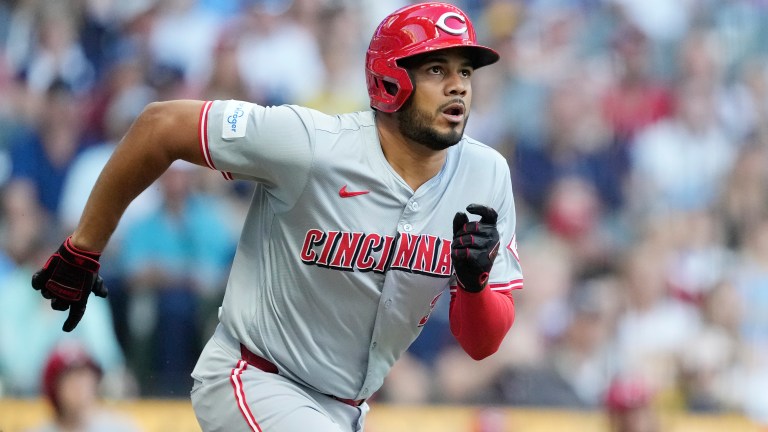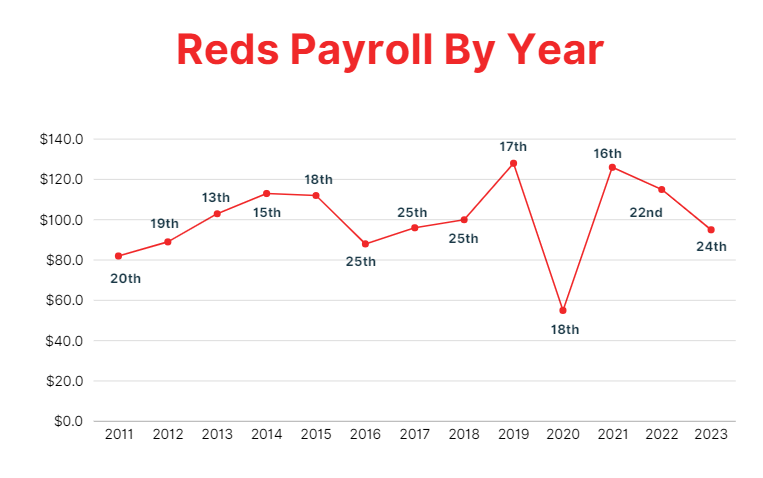Cincinnati Reds 2025 Payroll Outlook
The Cincinnati Reds have plenty of needs they have to consider this offseason, but how much room do they have in the payroll to address them?

Although the Reds offseason started a few weeks back, the official offseason is just around the corner. A time to dream up different combinations of moves that will surely lead the Reds back to October baseball. Trades, free agents, and prospects allow your mind to wonder about brighter days and bigger win totals.
However, before getting too deep into your offseason roster construction discussions, it is important to have a grasp on what is actually possible. To understand where the Reds are financially, historical trends, and what moves are possible.
I’ll start with what we know for sure – the current payroll. Below, thanks to Spotrac, I’ll outline the arbitration-eligible players, along with the players under contract or with options (in parenthesis). For players who are arbitration-eligible, I will state their projected number courtesy of Spotrac.
Cincinnati Reds Multi-Year Payroll
| Player | 2025 | 2026 | 2027 | 2028 | 2029 |
| Jeimer Canderalrio | $15m | $12m | $18m (Club) | FA | |
| Nick Martinez | $12m (Player) | FA | |||
| Ty France | Arb 3 – $8.4m | FA | |||
| Jake Junis | $8m (Mutal) | FA | |||
| Emilio Pagan | $8m (Player) | FA | |||
| Hunter Greene | $6.33m | $8.33m | $15.33m | $16.33m | $21m (Club) |
| Jonathan India | $5.4m | Arb 3 | FA | ||
| Tyler Stephenson | Arb 2 – $4.46m | Arb 3 | FA | ||
| Santiago Espinal | $3.66m | Arb 4 | FA | ||
| Luke Maile | $3.5m (Club) | FA | |||
| Brent Suter | $3.5m (Club) | FA | |||
| Alexis Diaz | Arb 1 – $2.67m | Arb 2 | Arb 3 | FA | |
| Jake Fraley | Arb 2 – $2.8m | Arb 3 | FA | ||
| Nick Lodolo | Arb 1 – $1.95m | Arb 2 | Arb 3 | FA | |
| Austin Wynns | Arb 2 – $1.2m | Arb 3 | FA | ||
| Tejay Antone | Arb 3 – $1.1m | FA | |||
| Sam Moll | Arb 1 – $1.1m | Arb 2 | Arb 3 | FA |
The following players are pre-arbitration and are projected to make $800,000: Elly De La Cruz, Christian Encarnacion-Strand, Noelvi Marte, Matt McLain, Will Benson, Blake Dunn, Stuart Fairchild, T.J. Friedl, Rece Hinds, Jacob Hurtubise, Nick Martini, Spencer Steer, Joey Wiemer, Andrew Abbott, Julian Aguiar, Brandon Leibrandt, Rhett Lowder, Christian Roa, Brandon Williamson, Graham Ashcraft, Fernando Cruz, Casey Legumina, Lyon Richardson, Tony Santillan, Carson Spiers, Yosver Zulueta.
I know that’s a lot of numbers and could be confusing. Long story short, the Reds are in a pretty good spot contract wise. None of the players in their last year of arbitration (about to hit free agency) are a must to keep around long term. Plenty young and talented players are not yet to arbitration and come at cheap number.
As much as we would all like to see an Elly De La Cruz long term deal, I would say it is not likely.
The only candidates I could see inked to a multi-year deal are Tyler Stephenson and Nick Martinez. Catchers are hard to find and the Reds could lock up Stephenson, buying out his arb 2 (2025) and arb 3 (2026) seasons in exchange for additional years. Martinez, 34 years old, could decline his option and test the open market if the Reds do not explore additional years.
As for the options on other players, the Reds could look to get creative with Junis to lower his number in 2025. France is unlikely to return at his number, and Espinal is a toss up, in my opinion. Pagan will likely accept his player option.
For this exercise, I’ll assume Wynns, France, and Maile do not return, and the other players do. I’ll also set Martinez at his projected market value of $18.7 million and Junis at his projected value of $4.3 million. I should note the qualifying offer for Martinez would be just over $21 million if the Reds elect to go that route.
Assuming arbitration numbers, options, and pre-arbitration retention, the Reds will be at about $103 million in payroll entering the offseason, give or take a few million.
Of course, that $103 million number can change depending on who is not retained, traded, options, extensions, and so on, but we will use it for this exercise. Knowing where Cincinnati stands, just how much do they have to spend?
Historical Trends
The best predictor of future behavior is past behavior. To think the Reds ownership group is suddenly going to spend $200 million on a team will leave you disappointed. However, the Reds have spent more than their 2023 total of roughly $95 million.

The totals above are from Spotrac and are the adjusted payrolls which is why 2020, the shorted season, is much lower. Regardless, the Reds have spent around $125 -$135 million in their peak seasons and with a young, inexpensive team, the Reds have some room to spend.
Some websites have the Reds around $95 million, but as we mentioned above, we will work with around $103 million for this exercise. That means the Reds could spend roughly $30ish million in free agency or trades without subtracting contracts or setting new records.
These numbers and projections could be clunky so let’s pivot to maybe a better tell – free agent contracts they have signed.
The Nick Castellanos, Mike Moustakas, Frankie Montas, and Jeimer Candelario deals averaged between $14-$16 million per year and were considered large deals for the Reds. So, are the Reds suddenly going to hand out $20+ million contracts to free agents? I do not think so.
A player like Anthony Santander, who’s market value is estimated at $17.7 million, could fit into the plans. White Sox outfielder Luis Robert is due $15 million this year with matching $20 million options for 2026 and 2027, if the Reds were willing to make a trade. Robert’s contract timeline lines up well with other core players arbitration timeline and could be a perfect fit.
Another interesting, and important, wrinkle is the mess from the Bally Sports TV situation. That situation is very complicated but essentially could result in the Reds receiving less money from their TV deal which could result in less money to spend.
Conclusion
With so many options and unknowns, it is hard to say just how much the Reds will be willing to spend this offseason. Upgrades are certainly needed to this roster and the higher priced free agents are more than a long shot at this point. We have lived through the coin flip that is signing mid-level $15 million deals, but the Reds might just be stuck in that spot.
After working through this exercise I have leaned more towards the trade route. Cincinnati has a solid farm system and young options that could be packaged in order to bring in a player that has not yet signed for bigger money.
To me, that is the most realistic route to improving the roster and avoiding the possibility of having bad contracts on the book once homegrown players are due for raises.

